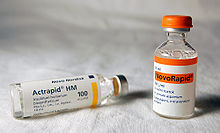
Back إنسولين (دواء) Arabic Inswlin (meddyginiaeth) Welsh Insulintherapie German Insulinoterapia Spanish انسولین (دارو) Persian Insuliinihoito Finnish Insuline (médicament) French Terapia insulinica Italian インスリン製剤 Japanese Инсулински препарат Macedonian
 Vials of insulin | |
| Clinical data | |
|---|---|
| Trade names | Humulin, Novolin, Insuman, others |
| AHFS/Drugs.com | Monograph |
| MedlinePlus | a682611 |
| License data | |
| Routes of administration | Subcutaneous, intravenous, intramuscular, inhalation |
| ATC code | |
| Legal status | |
| Legal status | |
| Identifiers | |
| CAS Number | |
| PubChem CID | |
| DrugBank | |
| ChemSpider | |
| UNII | |
| KEGG | |
| Chemical and physical data | |
| Formula | C257H383N65O77S6 |
| Molar mass | 5807.63 g·mol−1 |
| Density | 1.09 g/cm3 [4] |
| Melting point | 233 °C (451 °F) [5] |
As a medication, insulin is any pharmaceutical preparation of the protein hormone insulin that is used to treat high blood glucose.[6] Such conditions include type 1 diabetes, type 2 diabetes, gestational diabetes, and complications of diabetes such as diabetic ketoacidosis and hyperosmolar hyperglycemic states.[6] Insulin is also used along with glucose to treat hyperkalemia (high blood potassium levels).[7] Typically it is given by injection under the skin, but some forms may also be used by injection into a vein or muscle.[6] There are various types of insulin, suitable for various time spans. The types are often all called insulin in the broad sense, although in a more precise sense, insulin is identical to the naturally occurring molecule whereas insulin analogues have slightly different molecules that allow for modified time of action. It is on the World Health Organization's List of Essential Medicines.[8][9] In 2021, it was the 179th most commonly prescribed medication in the United States, with more than 2 million prescriptions.[10][11]
Insulin can be made from the pancreas of pigs or cows.[12] Human versions can be made either by modifying pig versions, or recombinant technology[12] using mainly E. coli or Saccharomyces cerevisiae.[13] It comes in three main types: short–acting (such as regular insulin), intermediate-acting (such as neutral protamine Hagedorn (NPH) insulin), and longer-acting (such as insulin glargine).[12]
- ^ "Humulin S (Soluble) 100IU/mL solution for injection in cartridge – Summary of Product Characteristics (SmPC)". (emc). Archived from the original on 5 August 2020. Retrieved 4 September 2020.
- ^ "Inpremzia EPAR". European Medicines Agency. 23 February 2022. Retrieved 3 March 2023.
- ^ "Inpremzia Product information". Union Register of medicinal products. Retrieved 3 March 2023.
- ^ Harding MM, Hodgkin DC, Kennedy AF, O'Conor A, Weitzmann PD (March 1966). "The crystal structure of insulin. II. An investigation of rhombohedral zinc insulin crystals and a report of other crystalline forms". Journal of Molecular Biology. 16 (1): 212–26. doi:10.1016/S0022-2836(66)80274-7. PMID 5917731.
- ^ Abel JJ (February 1926). "Crystalline Insulin". Proceedings of the National Academy of Sciences of the United States of America. 12 (2): 132–6. Bibcode:1926PNAS...12..132A. doi:10.1073/pnas.12.2.132. PMC 1084434. PMID 16587069.
- ^ a b c American Society of Health-System Pharmacists. "Insulin Human". www.drugs.com. Archived from the original on 22 October 2016. Retrieved 1 January 2017.
- ^ Mahoney BA, Smith WA, Lo DS, Tsoi K, Tonelli M, Clase CM (April 2005). "Emergency interventions for hyperkalaemia". The Cochrane Database of Systematic Reviews. 2005 (2): CD003235. doi:10.1002/14651858.CD003235.pub2. PMC 6457842. PMID 15846652.
- ^ World Health Organization (2019). World Health Organization model list of essential medicines: 21st list 2019. Geneva: World Health Organization. hdl:10665/325771. WHO/MVP/EMP/IAU/2019.06. License: CC BY-NC-SA 3.0 IGO.
- ^ World Health Organization (2021). World Health Organization model list of essential medicines: 22nd list (2021). Geneva: World Health Organization. hdl:10665/345533. WHO/MHP/HPS/EML/2021.02.
- ^ "The Top 300 of 2021". ClinCalc. Archived from the original on 15 January 2024. Retrieved 14 January 2024.
- ^ "Insulin Human; Insulin Isophane Human - Drug Usage Statistics". ClinCalc. Retrieved 14 January 2024.
- ^ a b c British national formulary: BNF 69 (69 ed.). British Medical Association. 2015. pp. 464–472. ISBN 978-0-85711-156-2.
- ^ Baeshen NA, Baeshen MN, Sheikh A, Bora RS, Ahmed MM, Ramadan HA, et al. (October 2014). "Cell factories for insulin production". Microbial Cell Factories. 13 (1): 141. doi:10.1186/s12934-014-0141-0. PMC 4203937. PMID 25270715.
© MMXXIII Rich X Search. We shall prevail. All rights reserved. Rich X Search